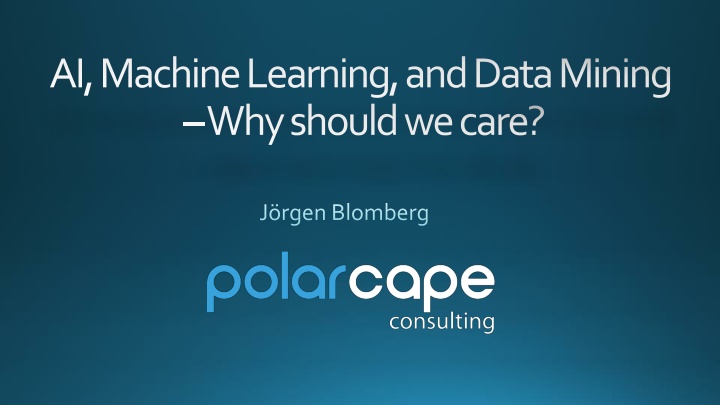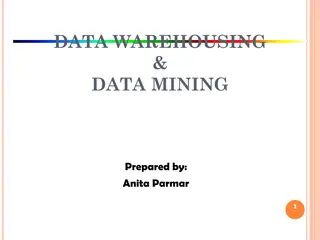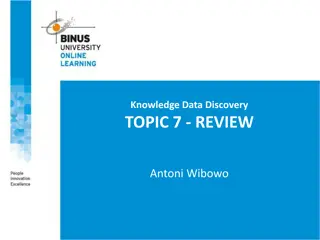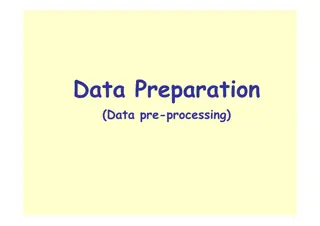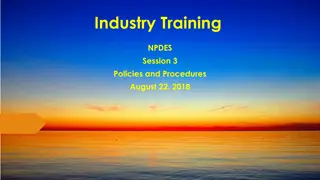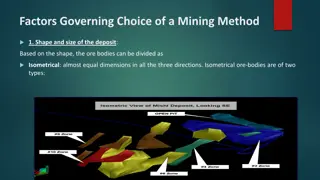AI, Machine Learning, and Data Mining - Why Care About Them?
Artificial Intelligence (AI), Machine Learning, and Data Mining play crucial roles in modern technology and business strategies. Understanding the significance of these fields is essential for leveraging their potential to drive innovation and achieve business objectives. AI is not about making computers think like humans but rather enabling them to analyze unstructured data effectively to achieve specific goals. The difference from normal programming lies in AI programming, where systems are trained by feeding them data and optimizing based on feedback to reach desired outcomes efficiently. Artificial Neural Networks, inspired by the brain's neurons and synapses, are a common AI implementation that processes information through interconnected nodes. Embracing AI, Machine Learning, and Data Mining can unlock opportunities for businesses to gain competitive advantages and enhance decision-making processes.
Download Presentation

Please find below an Image/Link to download the presentation.
The content on the website is provided AS IS for your information and personal use only. It may not be sold, licensed, or shared on other websites without obtaining consent from the author.If you encounter any issues during the download, it is possible that the publisher has removed the file from their server.
You are allowed to download the files provided on this website for personal or commercial use, subject to the condition that they are used lawfully. All files are the property of their respective owners.
The content on the website is provided AS IS for your information and personal use only. It may not be sold, licensed, or shared on other websites without obtaining consent from the author.
E N D
Presentation Transcript
AI, Machine Learning, and Data Mining Why should we care? J rgen Blomberg
ARTIFICIAL INTELLIGENCE 2 Delivering Business Value throughIT
Artificial Intelligence Been around since 1955 What it isn t: Making a computer think like a human. What it is: Computers making conclusions from unstructured input and finding the most effective way to reach a specific goal, based on the input. It is not everything we call intelligence but rather problem solving 3 Delivering Business Value through IT
Difference from normal programming Imperative programming You tell the computer what to expect, what to do with it, and how. If the input isn t what we expect, the program will not execute properly. 4 Delivering Business Value through IT
Difference from normal programming AI programming You define the goals, and train the system by feeding it data, optimizing by giving feedback until you efficiently reach the goals. Input Output Feedback P ? No, B O ? No, A U ? No, V W ? Yes. V ? Yes 5 Delivering Business Value through IT
Artificial Neural Networks A common implementation of AI (Loosely) modelled on neurons and synapses in the brain 6 Delivering Business Value through IT
Artificial Neural Networks Neurons (circles) add all incoming connections and if the sum exceeds the neuron s threshold the neuron fires and sends a value to all outgoing connections. 0.1 0.3 < 0.5 0 0.1 0.1 7 7 Delivering Business Value through IT
Artificial Neural Networks Neurons (circles) add all incoming connections and if the sum exceeds the neuron s threshold the neuron fires and sends a value to all outgoing connections. 0.1 0.6 > 0.5 1 0.2 0.3 8 8 Delivering Business Value through IT
Artificial Neural Networks Input Layer Hidden Layer Output Layer 9 Delivering Business Value through IT
Artificial Neural Networks Sum and threshold functions Threshold functions Weight functions Weight functions Sum and threshold functions Normalizing functions 10 Delivering Business Value through IT
Artificial Neural Networks Each connection has a weight (a multiplier on the outgoing data). When training the network: Positive results: reinforce the weights and/or thresholds for the firing neurons (Back propagation) Negative results: do the opposite (decrease weights and increase thresholds for firing neurons) 11 Delivering Business Value through IT
OCR again Input Output Feedback P ? No, B O ? No, A U ? No, V W ? Yes. V ? Yes 12 Delivering Business Value through IT
OCR a poorly written g (or is it a 9?) 13 Delivering Business Value through IT
OCR bounding box 14 Delivering Business Value through IT
OCR - grid 15 Delivering Business Value through IT
OCR find cells with more than 50% black 16 Delivering Business Value through IT
OCR what? 17 Delivering Business Value through IT
OCR how its actually done 18 Delivering Business Value through IT
Why AI is still hard Neural networks are generic and easy to build. Finding good ways to input data is hard. 19 Delivering Business Value through IT
NN in practice Pre- Post- prepared input Unstructured data NN NN output processing processing phoneme sound vector Sound data from mic NN Mapping tokens to apps, search terms, contacts etc. Sound processing: (Noise removal, Sampling, Transients, Slicing, etc.) Sequence of tokens 20 Delivering Business Value through IT
What can an AI do (well)? Classification Character recognition, automated synopsis, medical diagnostics Regression Numerical analysis Clustering Data optimization, customer behavior analysis Dimensionality reduction Eliminating irrelevant data to simplify analysis 21 Delivering Business Value through IT
MACHINE LEARNING 22 Delivering Business Value through IT
Machine Learning Been around since 1959 What it is: Self-modifying (AI) systems, optimizing for defined goals 23 Delivering Business Value through IT
Supervised learning Someone, the trainer , tells the system when the goals are reached and when not (right or wrong) Like in the OCR example Both input and output are structured or labeled . The trainer supplies a mapping from input to output. Can be used to optimize the cost of reaching goals but not find anything new 24 Delivering Business Value through IT
Unsupervised learning The input, and sometimes the output, is unstructured (no labels) and only the goals are defined Reaching any goal is a positive Can be used to find hidden patterns Examples: Customer behavior analysis - clustering Automated testing 25 Delivering Business Value through IT
Reinforced learning Gamified version of supervised or unsupervised learning. A ruleset of rewards and punishments is used to give feedback. Examples: Game AI: Chess, Go, RTS Self-driving cars Financial analysis 26 Delivering Business Value through IT
Genetic algorithms 1. Start with set of instances with randomized parameters. 2. Let all instances try to reach the goals a number of times. 3. Keep those who perform best in reaching the goals. Discard the rest. 4. Create a new set with the best from 2. and the rest being slightly modified ( mutated ) versions of those. 5. Repeat step 2-4 until one or more instances perform well enough. 27 Delivering Business Value through IT
Deploying ML systems Deploy as-is (Keep learning) Works for supervised systems Can potentially deteriorate and need resetting Deploy fully trained system (Stop learning) Works for retail apps or embedded systems Keeps performing as expected. You don t want your self-driving car to suddenly invent a faster way to get across town 28 Delivering Business Value through IT
DATA MINING 29 Delivering Business Value through IT
Data mining Been around since 1968 What it is: Processing large amounts of data to find patterns or trends. Used for: Quantitative (financial) analysis Customer behavior analysis Trend forecasting And many more applications Can give misleading results if the analysts using the data don t have a clear picture of the underlying data AI and unsupervised learning work well for finding new patterns. (With the above in mind ) 30 Delivering Business Value through IT
SO, WHAT IS NEW? 31 Delivering Business Value through IT
What is new? More data available to analyze. Combinations of AI/ML/Data Mining. Better algorithms and understanding of the math behind the algorithms. New applications for AI. Better hardware. 32 Delivering Business Value through IT
Big Data & The Cloud Internet + smartphones + IoT = a lot more data captured. Big data allows storage of huge amounts of unstructured data. Cloud storage allows reuse and sharing of data across systems and applications. 33 Delivering Business Value through IT
Deep learning Deep in this case refers to the depth of a neural network, i.e. the number of hidden layers. Specialized hardware can support several more hidden layers and handle the exponential growth in complexity better then other architectures. Can find multiple localized sub-goals very quickly and the aggregate the results. Example: Google s AlphaGo 34 Delivering Business Value through IT
? ? ? ? ?(?) ?(?) ? ? ? = 35 Delivering Business Value through IT
Bayes Theorem ? ? ? ?(?) ?(?) ? ? ? = The basis for Bayesian statistics 36 Delivering Business Value through IT
Bayesian statistics Bayes theorem and it s applications leads to better ways of analyzing data. Bayesian networks can be used to model probabilities in a way that works well for AI. Bayesian programming a way to construct solutions for problems with less data than necessary. 37 Delivering Business Value through IT
State of the industry Behavior analysis Machine/Human interaction Automation 38 Delivering Business Value through IT
